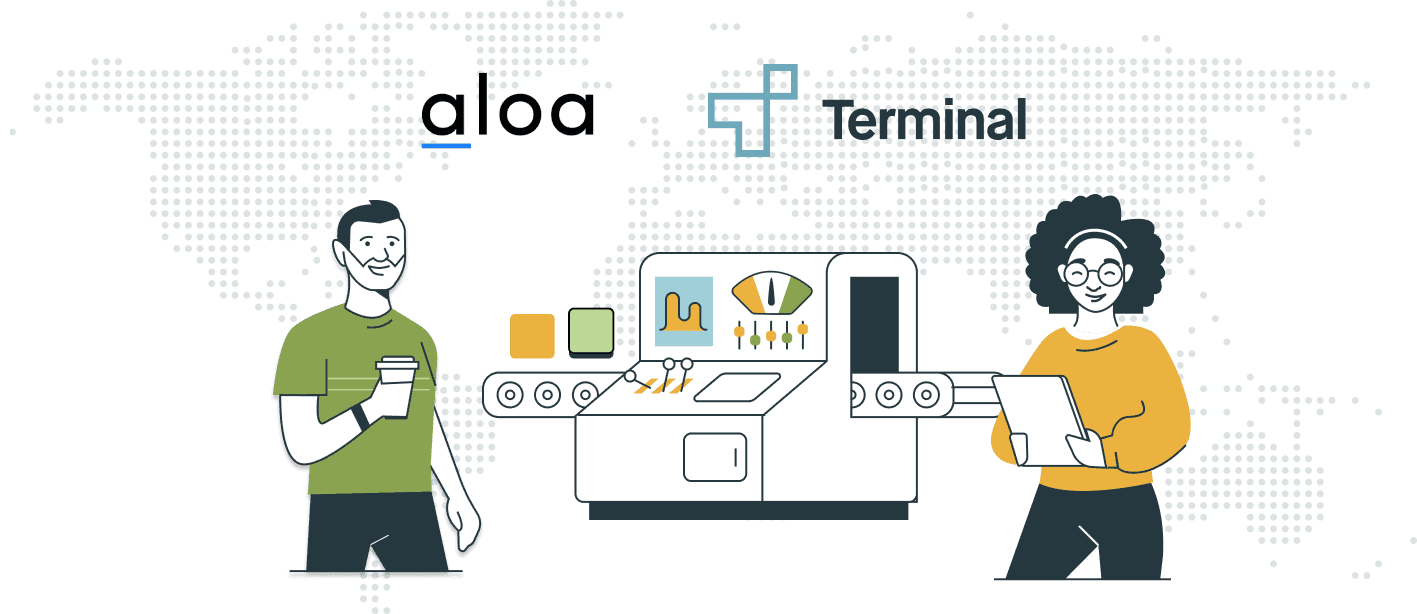
Hiring + recruiting | Blog Post
Aloa vs Terminal: What is the Best Alternative for Hiring Developers in 2024?
Adesuwa Ebuehi
Share this post
Aloa.co is a known player in the competitive nearshore tech talent hiring industry. If you’re in the continental US and looking to hire developers close to home, you’re probably curious about Aloa. But lucky you! You’ve found this article and are about to discover an even better option: Terminal.
Terminal is Aloa’s biggest competitor in the nearshore hiring industry. It has a stellar reputation among US tech startups and software developers in regionally aligned countries. In this article, we’ll compare Aloa and Terminal, highlighting their key differences to see why Terminal is the best alternative for hiring developers in 2024.
What Is Aloa?
Aloa is a nearshore tech solutions company based in Nashville, Tennessee. Its developer talent pool and partner network span several Latin American and Eastern European countries.
The company specializes in sourcing and hiring nearshore software developers from Latin America and Eastern Europe and augmenting developer project teams. Additionally, it provides project outsourcing services, working with its onshore software specialists to undertake software development projects. The platform website advertises that it has provided this service to 250+ clients thus far.
What Is Terminal?
Terminal is the most reputable nearshore software developer hiring agency in the Americas, with a talent network spanning Latin America, Eastern Europe, Canada, and Spain. The platform vets thousands of candidate software engineers, mainly accepting the cream of the crop but also maintaining a balanced pool of various talent levels, from senior to elite.
Terminal’s unique melding of smart technology with human talent sourcing experience makes its talent matching the most precise and reliable in its niche. So, it’s little surprise that this company is the favored project team-building solution for hundreds of big and small US tech startups, including GoPro, Calendly, and Him & Hers.
Aloa vs. Terminal
Now that we have a basic idea of what Aloa and Terminal are, let’s compare them and see which one wins on each of these factors:
- Talent sourcing
- Talent screening
- Hiring flexibility
- Hiring process
- Hiring costs
- Developer roles and specialties
- Client incentives and promos
Talent Sourcing
Remote talent sourcing is a specialty with its own methods, practices, and principles. The exact techniques differ between platforms depending on niche and operating model, but some methods are more effective than others in the fast-paced contemporary talent recruitment industry. So, how do Aloa and Terminal source talent, and which of them is better at it?
We’ll also consider the geographical scope of talent sourcing for Aloa and Terminal, a factor that significantly affects each platform’s quality and diversity of talent.
Aloa
Aloa takes a relatively traditional but practical approach to recruiting talent, leveraging interrelationships and community networks. The platform relies heavily on its partners and employees, who use their social and professional networks to bring in promising talent through referrals. However, it also uses other contemporary methods like posting job openings on social media platforms and online job boards, using just a little AI processing power to sort through applications.
Aloa recruits talent from across Latin America and Eastern Europe. However, it doesn’t specify what countries it recruits from, which can be inconvenient for enquirers and potential clients.
Terminal
Terminal is all about using the most contemporary and efficient methods for everything, including talent sourcing. Thus, while it applies traditional sourcing methods like referrals, it also takes the Silicon Valley approach, forging strategic partnerships with top universities, and organizing online – and sometimes physical – symposiums and networking events with top industry executives.
The platform’s recruitment network covers nine up-and-coming talent markets, including Canada, Latin American countries like Mexico, Chile, Colombia, and Costa Rica, and European countries like Poland and Spain. Consequently, Terminal has a broader geographical scope than Aloa. Thanks to its solid reputation among software developers in these regions, Terminal has little trouble finding and onboarding fresh and experienced talent.
Talent Screening
With millions of candidates posting resumes to different platforms, an ideal hiring network must have a screening system that can reliably cut through the noise and find the signal. The vetting procedures must also be sophisticated enough to recognize unique capabilities in individual candidates, especially since clients with custom sourcing requirements may require such talents. So, let us compare Aloa and Terminal and see which is better at talent screening.
Aloa
Aloa’s website does not contain any information on how it screens its candidates, which can be frustrating for anyone trying to see how well the platform handles the task. The website does allow you to download ‘Aloa’s Playbook,’ a document that ostensibly shows you all of the company’s insights into talent sourcing and screening and might tell you something about the in-house screening procedures. However, we requested a copy but got none.
Still, we presume the Aloa candidate screening procedure may include some language proficiency testing. One of the platform’s blog posts lists reference checks for past projects, portfolio reviews, phone call interviews, and coding exercises as part of the ‘traditional technical assessment’ process. We might reasonably suppose that Aloa also performs these assessments on its candidates, but we still have no specifics or idea of how rigorous the process is.
Terminal
In sharp contrast to Aloa, Terminal is very transparent about its vetting process. The website Terminal lists the pre-screening procedures candidates undergo and the reasons for each. It also mentions that only 7% of its candidates, the cyber elite, pass its pre-screening process.
Firstly, while the candidates come from diverse linguistic backgrounds, they are hired by US companies, so English proficiency is critical. Candidates must display at least a professional working command of the English language, although the ideal is native or bilingual fluency.
Next, the vetting team assesses the candidates’ technical skills. The process involves software development exercises tailored to each candidate’s skill level and a series of interview questions on project handling. The tests also assess the candidate’s range with various individual and combined technologies, testing for unique talents and other side skills that might prove valuable.
Terminal also highly values ‘soft’ programmer skills that other platforms might consider less important. For example, candidates must display creativity, drive, agreeableness, and work ethic, which are vital for project teamwork. Initiative, adaptability, and accountability are also important, especially for candidates who must fill project leadership roles. Terminal tailors its interviews accordingly and scores its candidates using all these metrics.
Hiring Flexibility
Hiring flexibility is critical to meeting clients’ hiring demands and helping them scale their project teams, thus adapting to changing business demands and excelling in the industry. Whether the client needs quick and temporary individual staffing for brief tasks or longer-term staffing for major projects, a hiring platform should be capable of reliably delivering the required talent.
Aloa and Terminal both make positive claims in this regard. So, let’s examine both and see which actually delivers.
Aloa
Aloa’s services are just a tad flexible, offering two main ways to hire staff. Firstly, it allows you to hire dedicated teams of developers to undertake projects. However, such teams will operate independently of any in-house team on your end, and you can only hire them for long-term jobs. Additionally, dedicated team hiring is only available for funded startups, as it’s the most expensive option on the platform.
The cheaper alternative is staff augmentation, which involves Aloa providing you with developers on demand to extend your existing team for short-term projects. The downside of this option is that ‘short-term’ means 3 months at least. Essentially, Aloa affords only minimal flexibility in hiring for short-term projects.
Terminal
Terminal is a lot more flexible than Aloa regarding hiring options. Like Aloa, it specializes in hiring project teams but at a more affordable rate. Terminal also offers team augmentation, providing premier professional and cultural talent that can integrate well into your existing team.
However, Terminal goes even further and allows you to hire individual software engineers who can work on shorter-term tasks than augmentation staff. So, if you need a quick hand with a two-week project, Terminal is fully capable of meeting that need.
Finally, Terminal allows you to hire and manage your developer directly through your own entity or employer of record. And if you wish, you can upgrade your contracted developer to full-time status.
Hiring Process
Hiring developers from a platform should not be a hassle, nor should it consume time that is better spent working on the project at hand. Thus, a platform should streamline its hiring process and methods enough to provide you with an excellent professional fit in one try and finalize the hiring process in no time.
In this section, we’ll compare the hiring processes at Aloa and Terminal to see how each platform’s unique approach and methods affect how quickly and seamlessly you can hire remote developers.
Aloa
Aloa’s process seems quite time-consuming. To commence the process, you place a request on the website, and an Account Executive contacts you to learn more about you, your business and its industry use cases, your technical requirements, and your working style.
Next, the matching team selects the best candidates depending on your request – the number of candidates depends on whether you request staff augmentation or dedicated teams. Then, the Account Executive sets up interviews with the candidates and helps finalize the contracts once you have taken your pick.
Aloa’s service also covers onboarding, periodic performance reviews, and salary management to facilitate your relationship with your new developer team. However, the platform does not specify where the cost of these services lies. It also doesn’t indicate the hiring speed, and we couldn’t find any relevant information from past Aloa clients, which is odd.
Terminal
Terminal’s hiring process is straightforward and streamlined. You simply get on the website, place a quick request with your specifications, and wait for the algorithm to bring you the best matches. The platform always has hundreds of developers on standby, all ready to be interviewed for core skills, so it takes almost no time to present you with the best-fitting candidates.
Terminal’s state-of-the-tech AI algorithms make the matching process so reliable that you can expect to find enough perfect fits on the first attempt as to have some difficulty choosing. But don’t worry; the platform’s highly experienced specialists can help you there.
Custom sourcing requests may take longer to find matches for, sometimes up to a month. But no matter how precise your requirements are, Terminal assures you of a 40% faster hiring process than the competition.
Terminal’s service also includes talent onboarding, performance monitoring, management, and payroll arrangements.
Hiring Costs
Hiring costs can be a significant concern, especially if you’re operating on a tight budget. These costs range from recruitment fees and onboarding costs to salaries and replacement charges. One test of an excellent hiring platform is its ability to give you breathing space on these costs without compromising the quality of its developers and the general hiring and working experience. However, not all platforms are founded equal in this regard, and we’re about to test the accuracy of this notion concerning Aloa and Terminal.
We’ll compare the expenses you incur on these two platforms and see which is more favorable for your budget.
Aloa
Aloa is completely opaque about its pricing structure, offering no information on its website about how much its services cost. Presumably, you can only find that out when you reach the cost assessment stage of the hiring process. We could also find no user reviews online to give us a picture of the pricing structure.
Terminal
Terminal offers a transparent and cost-efficient pricing structure that saves you up to 40% in hiring and overhead costs, owing to the timezone alignment between the US and Latin America. There are no non-refundable upfront costs or hidden charges to worry about.
The platform allows developers to set their own monthly rates but imposes lower and upper limits of $4000 and $12000, respectively. The exact cost depends on the developer’s expertise and whether you’re hiring an individual or a team. A small extra fee – a few hundred or thousand dollars, depending on the hiring arrangement – covers everything from onboarding and management to periodic performance assessment.
Developer Roles and Specialties
Many specialties exist in software development technology, ranging from full-stack development and cybersecurity to machine learning and data science. Accordingly, any software development project requires different professional roles, from project managers and software architects to QA testers and product managers. Regardless of your project’s specifics, your best bet for reliable staffing is an agency that recruits for all software development roles and specialties.
So, which of our two starring platforms has the scope to fill any project roles for you?
Aloa
Aloa has developers specializing in various technologies, including mobile OSes like iOS and Android, database systems like MongoDB, and programming languages like JavaScript, Laravel, and Python. It also has a few specialists in emerging technologies like AR/VR, Web3, and IoT. However, it lacks specialists in the booming field of AI development and machine learning.
As for job roles, Aloa can supply specialists to fill a range of project roles – at least, we presume so since the platform isn’t specific about which roles it can fill.
Terminal
Terminal has a vastly greater scope than Aloa when it comes to software development specialties. It covers everything from PC and Mobile OSes to database management systems, a plethora of programming languages, and emerging technologies like AR/VR and, especially, AI and machine learning. Indeed, Terminal is one of the leading platforms for hiring AI and ML developers.
Terminal’s talent pool is full of specialists in all software project roles. You can easily find manual and automated QA testers, engineering managers, data engineers, DevOps engineers, data scientists, and even SDETs.
Client Incentives and Promos
Everybody loves a platform that gives a little something back to its clients. As a recruiter or hirer, there’s no reason the platform you choose shouldn’t make your engagement worthwhile with special incentives like free trials, money-back guarantees, or periodic price slashes. And so, let’s see what juicy offers Aloa and Terminal have for you.
Aloa
With no free trials or other incentives on offer, there is precious little – if anything – to spice up your hiring experience on Aloa.
Terminal
Unlike Aloa, Terminal is very much interested in giving you good reasons for repeat business. Consequently, Terminal has two juicy free trial offers, one for contract hires and another for full-time hires.
If you hire a full-time developer or project team, you can enjoy a free trial and replacement offer lasting up to 3 months; if you hire on a contract basis, the offer lasts for 14 days after you sign the contract. Not that you’ll ever need to use these offers, anyway – Terminal hires are virtually never the wrong fit, with retainment rates up to 7 times higher than on competing platforms.
Aloa vs Terminal: Which Is the Best For Hiring Developers?
Aloa and Terminal clearly differ in many key regards, but Terminal emerges as your best bet for hiring remote developers in 2024.
Thanks to a more transparent and affordable pricing structure, Terminal allows you to hire top-notch talent from 9 different without breaking the bank. Furthermore, the platform’s broad sourcing scope and sophisticated screening process enable it to satisfy any skill requirement you have reliably and seamlessly.
Finally, in the unlikely event that you are unsatisfied with your hire, Terminal has replacement offers that you can invoke at no cost, unlike Aloa. So, why not connect to Terminal’s pipeline today and get an outstanding return on your hiring investment?


